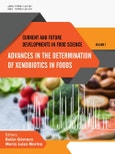Determining the presence of different types of toxic compounds (or xenobiotics) in food requires precise analytical methodologies. Examples of these techniques include separation techniques coupled to mass spectrometry, Variations in methods used depend on the physicochemical properties of each xenobiotic being tested for.
Advances in the Determination of Xenobiotics in Foods explains recent developments in the field of xenobiotic determination in food. Readers are introduced to xenobiotic testing techniques through extensive reviews. Chapters also cover details about contaminants coming from food contact materials (such as plasticizers, food additives, polymer monomers/oligomers, and non-intentionally added substances), substances used for food processing and sensing (nanoparticles), and residues of pesticides (that can also be present in the final food product). The book also includes information about specific xenobiotics that, due to their global distribution in the environment, are also likely to enter the food chain. Some of them are regulated (persistent organic pollutants and heavy metals) but there are many other types of contaminants (halogenated flame-retardants, perfluorinated compounds and micro- and nano-plastics) that must also be controlled.
In addition, some xenobiotics could be present in the final food consumed because of food treatments (acrylamide, furan, heterocyclic aromatic amines, and glycidol esters). Finally, the concluding chapters of the book are devoted to the presence of natural contaminants such as mycotoxins and biogenic amines.
The combination of extensive information of analytical techniques for xenobiotics along with a categorical treatment of food contaminants makes this volume a handy reference for food science and technology students and technicians involved in food safety and processing management roles.
Table of Contents
Chapter 1
- Safety Assessment of Active Food Packaging: Role of Known and Unknown Substances
Chapter 2
- Microplastics and Nano-plastics in Food
Chapter 3
- Nanotechnology in the Food Field: Application of Metal-based Nanoparticles
Chapter 4
- Halogenated and Organophosphorus Flame Retardants
Chapter 5
- Dioxins and PCBS in Food and Feed Matrices: Advances in Physico-Chemical Methods and EU Regulatory Framework
Chapter 6
- Pesticides
Chapter 7
- Perfluoroalkyl Substances (PFASS) in Foodstuffs and Human Dietary Exposure
Chapter 8
- Mercury
Chapter 9
- Process Contaminants
Chapter 10
- Mycotoxins
Chapter 11
- Biogenic Amines
Samples

LOADING...
Author
- Belen Gomara
- Maria Luisa Marina








